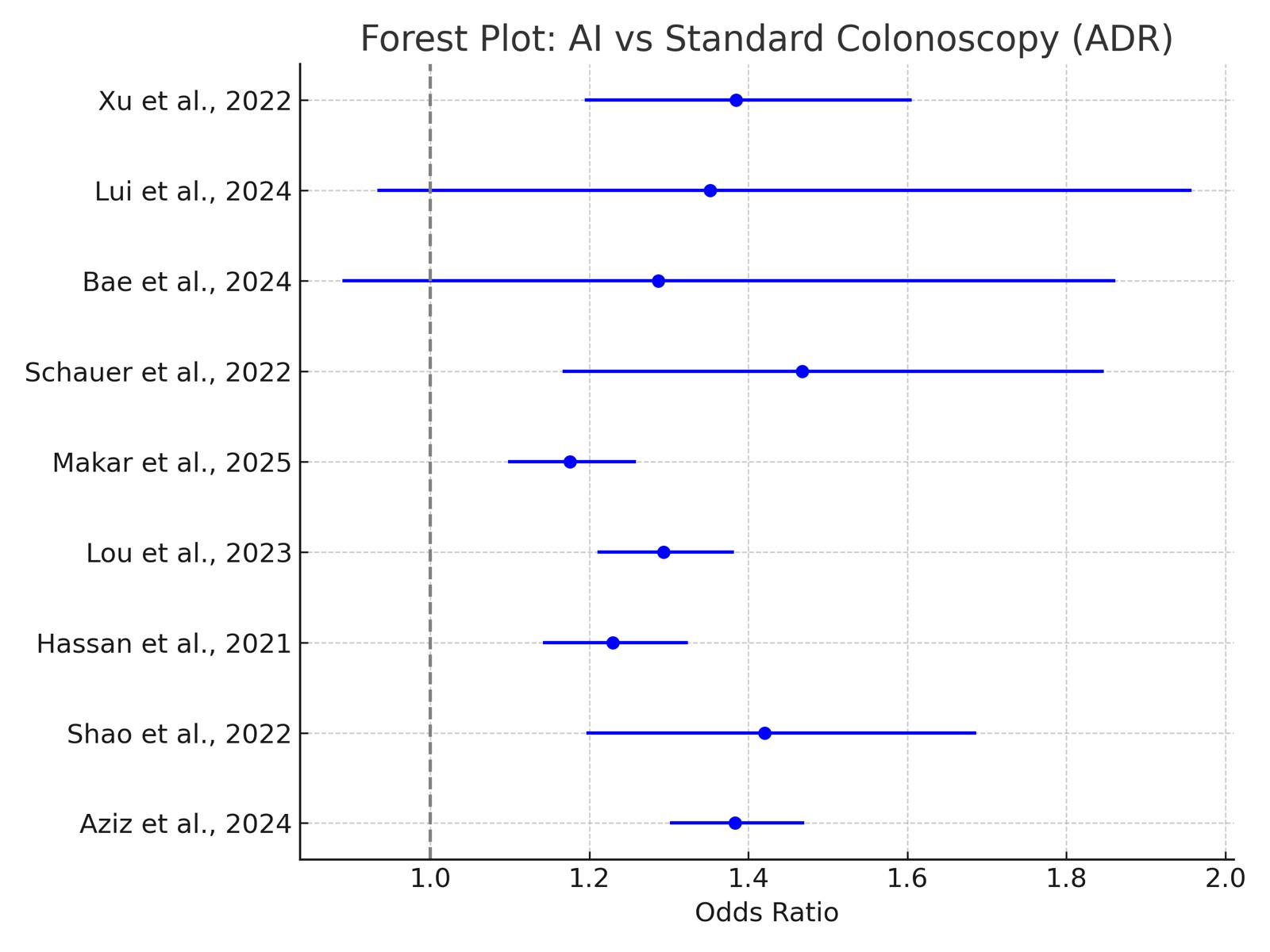Tuesday Poster Session
Category: Colorectal Cancer Prevention
P4750 - AI-Enhanced Colonoscopy Improves Adenoma Detection Without Delaying Procedure: Meta-Analysis of 9,500 Patients
Tuesday, October 28, 2025
10:30 AM - 4:00 PM PDT
Location: Exhibit Hall

Prince Shah-Riar, MD (he/him/his)
DHR Health, Edinburg, Tx
Edinburg, TX
Presenting Author(s)
Prince Shah-Riar, MD1, Tourna Nahrin NAHRIN. Khan, MBBS2, Sadia Afrin Naurin, MBBS3, Rishika Trivedi, MD4, Asif Zamir, MD, FACG5
1DHR Health, Edinburg, Tx, McAllen, TX; 2University of Illinois Urbana-Champaign, Champaign, IL; 3Ibrahim Medical College, Tallahassee, FL; 4DHR Health, McAllen, TX; 5DHR Health Gastroenterology, Edinburg, TX
Introduction: Colorectal cancer (CRC) is a major global health challenge, with nearly two million new cases reported in 2020. Colonoscopy is the cornerstone of CRC prevention, and adenoma detection rate (ADR) is a validated performance metric inversely associated with interval CRC. Yet, ADR varies significantly among endoscopists. Computer-aided detection (CADe) systems using artificial intelligence (AI) offer real-time support that may improve detection consistency. While single studies and trials suggest benefit, a robust synthesis across diverse settings is lacking.
Methods: Following PRISMA guidelines, we searched PubMed, Embase, Cochrane Library, and ClinicalTrials.gov (2000–2024) using terms such as “AI-assisted colonoscopy” and “adenoma detection.” Eligible studies included randomized controlled trials and cohort studies comparing AI-assisted to standard colonoscopy and reporting ADR, polyp detection rate (PDR), and missed adenoma rate (MAR). Two independent reviewers assessed study quality using Cochrane Risk of Bias and Newcastle-Ottawa tools. Pooled odds ratios (ORs) with 95% confidence intervals (CIs) were calculated using a random-effects model. Publication bias was evaluated using Egger’s test and funnel plots.
Results: Thirty-eight studies (22 RCTs, 16 cohort studies) including 9,500 patients were analyzed. AI-assisted colonoscopy significantly increased ADR (31.5% vs 25.3%; OR 1.48, 95% CI 1.35–1.62; p< 0.01) and PDR (48.2% vs 39.4%; OR 1.42, 95% CI 1.30–1.53; p< 0.01). MAR from tandem studies was significantly lower in the AI group (16.9% vs 24.5%; p=0.01). Detection of diminutive adenomas (< 5 mm; p=0.02) and sessile serrated lesions (p=0.03) also improved. No significant difference in withdrawal time was found (p=0.07). Findings align with key multicenter trials including COLO-DETECT (OR 1.47, 95% CI 1.21–1.78; p< 0.0001). No significant publication bias was observed.
Discussion: AI-enhanced colonoscopy significantly improves ADR and reduces missed lesions, including subtle and flat polyps, without extending procedure time. These findings support routine AI integration into colorectal cancer screening to enhance diagnostic consistency and potentially reduce interval cancers.

Figure: Forest Plot of ADR: AI-Assisted vs. Standard Colonoscopy (Individual Study Estimates with 95% CI)

Figure: AI vs. Standard Colonoscopy: Detection Metrics and Odds Ratios
Disclosures:
Prince Shah-Riar indicated no relevant financial relationships.
Tourna Nahrin Khan indicated no relevant financial relationships.
Sadia Afrin Naurin indicated no relevant financial relationships.
Rishika Trivedi indicated no relevant financial relationships.
Asif Zamir indicated no relevant financial relationships.
Prince Shah-Riar, MD1, Tourna Nahrin NAHRIN. Khan, MBBS2, Sadia Afrin Naurin, MBBS3, Rishika Trivedi, MD4, Asif Zamir, MD, FACG5. P4750 - AI-Enhanced Colonoscopy Improves Adenoma Detection Without Delaying Procedure: Meta-Analysis of 9,500 Patients, ACG 2025 Annual Scientific Meeting Abstracts. Phoenix, AZ: American College of Gastroenterology.
1DHR Health, Edinburg, Tx, McAllen, TX; 2University of Illinois Urbana-Champaign, Champaign, IL; 3Ibrahim Medical College, Tallahassee, FL; 4DHR Health, McAllen, TX; 5DHR Health Gastroenterology, Edinburg, TX
Introduction: Colorectal cancer (CRC) is a major global health challenge, with nearly two million new cases reported in 2020. Colonoscopy is the cornerstone of CRC prevention, and adenoma detection rate (ADR) is a validated performance metric inversely associated with interval CRC. Yet, ADR varies significantly among endoscopists. Computer-aided detection (CADe) systems using artificial intelligence (AI) offer real-time support that may improve detection consistency. While single studies and trials suggest benefit, a robust synthesis across diverse settings is lacking.
Methods: Following PRISMA guidelines, we searched PubMed, Embase, Cochrane Library, and ClinicalTrials.gov (2000–2024) using terms such as “AI-assisted colonoscopy” and “adenoma detection.” Eligible studies included randomized controlled trials and cohort studies comparing AI-assisted to standard colonoscopy and reporting ADR, polyp detection rate (PDR), and missed adenoma rate (MAR). Two independent reviewers assessed study quality using Cochrane Risk of Bias and Newcastle-Ottawa tools. Pooled odds ratios (ORs) with 95% confidence intervals (CIs) were calculated using a random-effects model. Publication bias was evaluated using Egger’s test and funnel plots.
Results: Thirty-eight studies (22 RCTs, 16 cohort studies) including 9,500 patients were analyzed. AI-assisted colonoscopy significantly increased ADR (31.5% vs 25.3%; OR 1.48, 95% CI 1.35–1.62; p< 0.01) and PDR (48.2% vs 39.4%; OR 1.42, 95% CI 1.30–1.53; p< 0.01). MAR from tandem studies was significantly lower in the AI group (16.9% vs 24.5%; p=0.01). Detection of diminutive adenomas (< 5 mm; p=0.02) and sessile serrated lesions (p=0.03) also improved. No significant difference in withdrawal time was found (p=0.07). Findings align with key multicenter trials including COLO-DETECT (OR 1.47, 95% CI 1.21–1.78; p< 0.0001). No significant publication bias was observed.
Discussion: AI-enhanced colonoscopy significantly improves ADR and reduces missed lesions, including subtle and flat polyps, without extending procedure time. These findings support routine AI integration into colorectal cancer screening to enhance diagnostic consistency and potentially reduce interval cancers.

Figure: Forest Plot of ADR: AI-Assisted vs. Standard Colonoscopy (Individual Study Estimates with 95% CI)

Figure: AI vs. Standard Colonoscopy: Detection Metrics and Odds Ratios
Disclosures:
Prince Shah-Riar indicated no relevant financial relationships.
Tourna Nahrin Khan indicated no relevant financial relationships.
Sadia Afrin Naurin indicated no relevant financial relationships.
Rishika Trivedi indicated no relevant financial relationships.
Asif Zamir indicated no relevant financial relationships.
Prince Shah-Riar, MD1, Tourna Nahrin NAHRIN. Khan, MBBS2, Sadia Afrin Naurin, MBBS3, Rishika Trivedi, MD4, Asif Zamir, MD, FACG5. P4750 - AI-Enhanced Colonoscopy Improves Adenoma Detection Without Delaying Procedure: Meta-Analysis of 9,500 Patients, ACG 2025 Annual Scientific Meeting Abstracts. Phoenix, AZ: American College of Gastroenterology.
